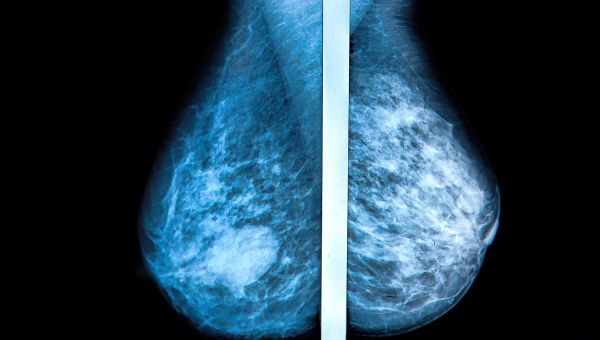The Surprising Breast Cancer Risk Factor You May Not Know About

Getting regular mammograms, which are x-rays that check for any changes in breast tissue, is the key to early detection of breast cancer. But many women are confused by their mammogram results, especially when it comes to dense breast tissue.
One small 2018 study published in Patient Education & Counseling found that of 30 women who received notification that they had dense breast tissue, 81 percent of them recalled receiving the result, but didn’t understand what it meant. And, many of these women interpreted the results in ways that were much different than the medical explanation.
However, dense breast tissue is very common. In fact, half of women 40 and over who get mammograms have dense breasts. But how does it actually affect your health?
To put your mind at ease, here’s some information about dense breast tissue and how it relates to cancer.
What is dense breast tissue?
Breasts are made up of fibrous tissue, which impacts the size and shape of your breast and glandular tissue that produces milk. They also contain fatty connective tissue, as well as ducts that carry milk to the nipple. If breasts have more fibrous and glandular tissue than fat, they may be considered dense.
It’s important to know that there are many factors that contribute to your breast density, including, but not limited to, age, menopausal status, genetics, hormone use, menstrual cycle, chemotherapy treatments and body disposition.
How will you know if you have dense breast tissue?
Your breast density can only be seen through a mammogram. Dense breast notifications (DBN), or notifications provided by a radiologist or doctor after a mammogram if dense breast tissue is detected, aren’t provided in every state. However, many states in the US (34 to be exact, as of June 2018) require that women who have mammograms be notified in some way about breast density or their own breast density.
Many states also require that insurance cover any additional imaging tests like ultrasounds for women with dense breasts.
There are various density categories, according to the American College of Radiology, and they are classified into these four groups in the Breast Imaging Reporting and Data System (BI-RADS), or breast cancer and density risk results from your mammogram:
- A: Breasts are almost all fatty tissue, occurs in 10 percent of women
- B: Breasts have dispersed areas of dense glandular and fibrous tissue, occurs in 40 percent of women
- C: Breasts are mostly dense glandular and fibrous tissue, which can interfere with the detection of small tumors, occurs in 40 percent of women
- D: Breasts are very dense, which makes tumor detection within the tissue hard to spot, occurs in 10 percent of women
Your breasts are classified as dense if you have a C or D diagnosis.
If you live in one of the states that requires breast density information to be shared with patients, your mammogram report will also include BI-RADS results on cancer risk and density. Most breast density reports will use the A to D labeling system above. The language used in reports is required by law, and according to the American Cancer Society, usually reads something like this:
“Your mammogram shows that your breast tissue is dense. Dense breast tissue is common and is not abnormal. However, dense breast tissue can make it harder to evaluate the results of your mammogram and may also be associated with an increased risk of breast cancer. This information about the results of your mammogram is given to you so you will be informed when you talk with your doctor. Together, you can decide which screening options are right for you. A report of your results was sent to your primary physician.”
How do dense breasts affect your mammogram results?
Regardless of the state you live in or your breast density, your radiologist will compile your mammogram results using the BI-RADS. This report classifies your breast cancer risk into the following categories:
0: Additional information is needed
1: Negative
2: Benign
3: Probably benign
4: Suspicious abnormality
5: Highlight suggestive malignancy
6: Biopsy-proven malignancy
Dense breast tissue is very common, and although research shows that dense breast tissue may be linked to a slightly higher risk of breast cancer, the reason is not completely understood. One June 2018 Norwegian study, published in Radiology, found that mammograms detected 6.7 cancers per 1000 exams for women with dense breasts and 5.5 per 1000 for those with non-dense breasts. The study also revealed that of the 107,949 women involved, those with dense breasts were more likely to need further testing because of suspicious mammogram findings, and they were also more likely to have larger tumors when cancer was actually found.
Because breast tissue looks white, as do masses and tumors, it’s possible that dense breast tissue can prevent radiologists from detecting cancer during mammograms. As a result, your mammogram may not be as accurate as it would be if you had more fatty tissue.
Are there any steps you can take if you have dense breast tissue?
Many women understandably become stressed and anxious when they learn they have dense breast tissue, but the diagnosis doesn’t always mean you should be concerned.
While dense breast tissue is an individual risk factor for cancer, it’s not associated with a higher risk of dying from breast cancer when compared to women with breast cancer and fatty tissue.
If you have dense breast tissue, the most important thing to know is that you should talk with your doctor. He or she can discuss what breast density really means, how your dense breast tissue affects your breast cancer risk specifically and whether or not other screening options like ultrasounds or magnetic resonance imaging tests are necessary in your situation.
Sourcing: American Cancer Society, National Cancer Institute, UptoDate


